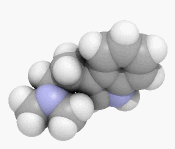Template:Cover abstract/Dimethyltryptamine

N,N-Dimethyltryptamine (DMT or N,N-DMT) is a hallucinogenic psychedelic compound of the tryptamine family. When ingested, DMT acts as an intense hallucinogenic drug. Its presence is known to be widespread throughout the plant kingdom. DMT is a close relative of the psychedelic drugs 5-HO-DMT and 5-MeO-DMT. Although various theories have been formulated, the compound's biological function has yet to be determined.
DMT results in powerful visuals and intense psychedelic mental effects when smoked, injected, insufflated, or taken orally (with an MAOI or RIMA such as Harmaline). When smoked, DMT is a powerful visionary psychedelic that produces short acting effects. When taken in combination with an MAOI or RIMA, it becomes orally active. DMT is present in over 65 species of plants. It has been used traditionally in South America in ayahuasca brews since at least around the year 1500 and archaeological evidence suggests its use in snuffs (such as yopo, cohoba, or parica) since 2080 BCE.
Depending on dose and method of administration, the effects of DMT can range from mild psychedelic states to powerfully immersive life-changing experiences-- the nature of which are often described as being the ultimate displacement from normal consciousness where users are placed in a subjective state in which they encounter ineffable spiritual/alien realms and alternate realities.